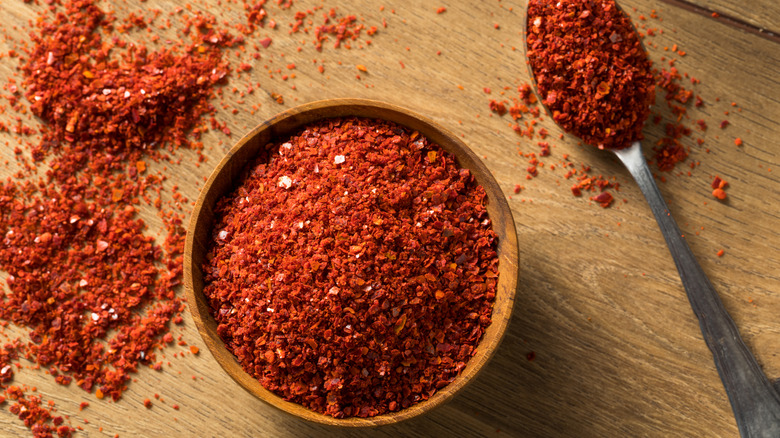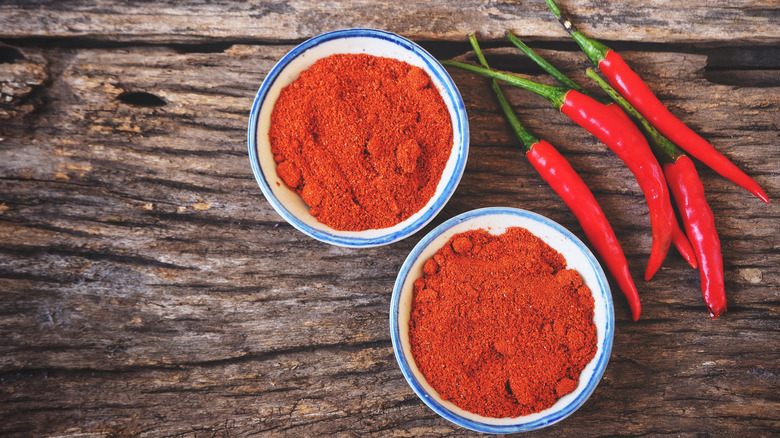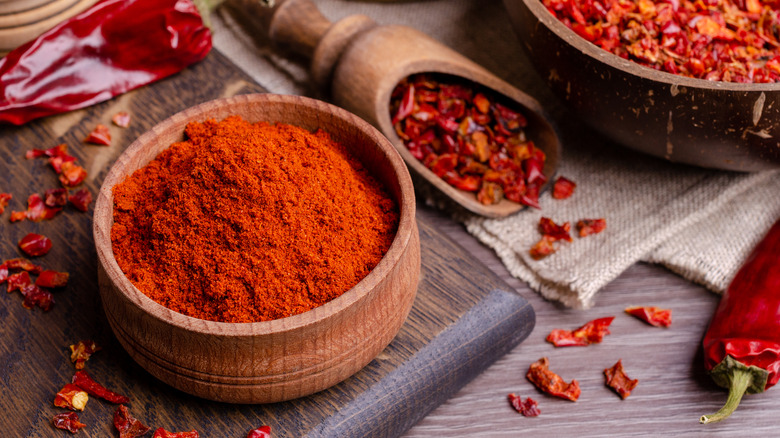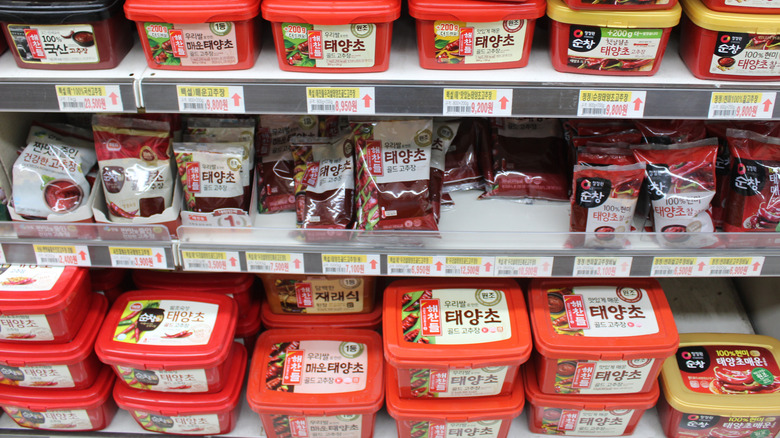What Is Gochugaru And What Is It Used For?
Considered one of the most important ingredients in Korean cooking by Maangchi, gochugaru is found in many classic Korean dishes, such as kimchi and sundubu jjigae (a spicy soup), as well as in spicy side dishes like Korean cucumber salad. While it is used to make the tabletop staple gochujang (a hot pepper condiment), both gochujang and gochugaru often appear in the same recipes.
While gochugaru may be a vital component of Korean cooking, it can be used in a wider variety of recipes, according to Allrecipes, such as for marinades for grilled meats, spicy salad dressings, and pickled vegetables. In fact, The New York Times says gochugaru has such a dynamic flavor that it tastes good sprinkled on nearly everything you make in your kitchen. If that is not reason enough to buy gochugaru for your kitchen pantry, Bon Appétit adds that unlike other pepper products, gochugaru has more complex flavors. Smokey, sweet, and fruity can all be used to describe the taste and smell of gochugaru. Not all gochugaru are the same, with there being two general kinds. The spicier version is called maewoon, per MasterClass, while the less spicy kind is called deol maewoon.
How gochugaru is made
Gochugaru is made from a specific kind of red chili pepper known as taeyangcho, per MasterClass, which give the red pepper flakes a smokey flavor, with a little undertone of fruity. Like so many products made with peppers, the level of spiciness is dependent on the number of pepper seeds incorporated into the ground finished product.
While gochugaru is widely available in stores, My Korean Kitchen said many Korean families make their own gochugaru after buying red chilis at markets. To make the chili flakes, all or most of the seeds are removed from the peppers and then the peppers are dried after being cleaned and trimmed. The peppers are then ground into flakes, often at an area rice mill, per My Korean Kitchen. For some of the highest quality store-bought gochugaru, look for the words "taekyung" or "taeyangcho", which indicate that the peppers were sun-dried, according to AllRecipes.
No comparison
There are a variety of pepper products available in the spice aisles of grocery stores. Most commonly found are bottles of cayenne pepper, chili powder, chipotle powder, and crushed red pepper flakes — and each has its own flavor. While both cayenne pepper and gochugaru are bright red in color, cayenne is ground to a finer consistency, per MasterClass. Cayenne also registers higher on the Scoville heat units with cayenne pepper coming in around 30,000 to 50,000 SHU while gochugaru's taeyangcho pepper is between 1,500 to 10,000 Scoville units. Chili powder, which is found in a wide variety of recipes across many cuisines, typically is created using a variety of peppers, says MasterClass. Because it does not taste too much of a certain pepper, it is highly versatile. Compared to gochugaru, its flavor is milder.
Chipotle powder is made from dried and smoked jalapeño peppers. Gochugaru is known for its bright red color, while chipotle is a deep red-brown. Red pepper flakes can contain a variety of peppers, such as bell and Jalapeño peppers, but never taeyangcho peppers. As a result, its flavor is a lot different than gochugaru. Maangchi has been asked if substituting chili powder or chili flakes for gochugaru can work, but she cautions against it. She said their flavor will be different. While it's not advisable to swap red pepper flakes for gochugaru, AllRecipes says to go ahead and use gochugaru in place of red pepper flakes or Aleppo pepper.
Where to buy gochugaru
Bottles of gochugaru can be purchased in Asian markets, specialty food stores, and sometimes in regular grocery stores. To purchase gochugaru, look for bottles that are described as Korean chili flakes, Korean pepper powder, or Korean red chili powder, according to MasterClass. One of the reasons it's important to look for a variety of names when buying gochugaru, per Maangchi, is because the Korean companies may not translate the label properly into English. If the labeling isn't clear, Maangchi says to look for red chili pepper flakes that are coarse and chunky.
Once unpacked at home, gochugaru should be frozen after being purchased to keep the ingredient fresh, advises Maangchi. Simply place the pepper flakes in a freezer bag and store for up to 6 months. Also keep a portion of gochugaru in the refrigerator for easy use. My Korean Kitchen says it's also acceptable to store the gochugaru in a cool, dry place. Should the gochugaru become clumped, put it in a food processor to break it up for better use.
How to use gochujaru
A key part of nearly every meal eaten in Korea, kimchi must be made with gochugaru for an authentic taste. The most popular kimchi to enjoyed in Korea, as well as abroad, is baechu kimchi made from Napa cabbage, and of course, gochugaru. Other types of kimchi, like ponytail kimchi (chonggak-kimchi) are also made with gochugaru.
Even dishes that are a fusion of Korean and American flavors contain gochugaru. For instance, a recipe for Army Stew calls for baechu kimchi, hot dogs, bacon, tofu, gochujang, and gochujaru, according to Korean Bapsang. For a single recipe of Army Stew, 1 tablespoon of gochujaru is recommended; however, for a spicier version, more of the red pepper flakes can be added. Gochujaru also makes its presence known on the streets of Korea where it is a major ingredient in the street food staple tteokboki, which can often be spotted from far away with bright red color and steam coming from the hot dish. Tteokboki is made from rice cake pieces, cabbage, garlic, and of course, gochujang and gochugaru, per Korean Bapsgang.
Don't limit your use of gochugaru to classic Korean dishes. The New York Times recommends using gochugaru with salmon for its light heat and fruity sweetness. The recipe for Gochugaru Salmon with Crispy Rice also includes maple syrup, vinegar, and butter.




